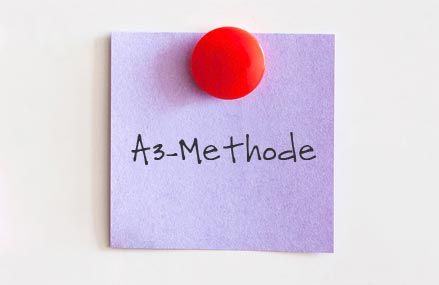
The A3-Method, also called the A3-Report, is a form on a Din-A3 sheet. The A3-Report is used in quality management to identify problems and develop solutions for process optimisation. Apart from texts, it also contains diagrams and other graphical elements to present information clearly and to enable a deepened understanding of contexts.
With the help of theA3-Report, employees learn to identify, analyse and solve problems themselves. - All with continuous improvement (CIP) in mind. The special feature of the A3-Report is that it makes the thought process for problem solving transparent, as users go through the individual analysis and action steps for problem solving one after the other, thus better understanding the problem and being able to design and implement sustainable solutions for a problem.
The A3-Report goes back to the industrial engineer Joseph Juan about 60 years ago he recommended that Japanese to managers noted problem solutions, decision-making principles and strategies for clarity’s sake on one piece of paper. Toyota followed this recommendation and chose the DIN A 3 format - hence the name.
Structure of the A3-Report
When solving a problem and implementing a new standard seven steps are made. On the left hand side of the form the four analytical steps that relate refer to the planning phase of the PDCA Cycle (plan-Do-Check-Act), also called the Deming circle are noted. The right hand side reflects the Do-Check-Act phases (execution, review, intervention) of the PDCA cycle.
Steps of the analysis in detail:
- 1.Background: the problem and its effect in relation to the achievement of a corporate goal is phrased in a clear and understandable manner for all persons involved. The importance of the problem and the reason for the pursued solution to the problem must be comprehensible.
- Current situation : The description of the current situation contains detailed facts, often in form of easy to understand graphic elements (pictures, graphs, charts or tables) to highlight the relevance of the problem for the company, to identify its place of origin and to show possible hurdles in its elimination.
- Target situation: the pursued target situation must be clearly defined as a goal. The objective makes the implementation of measures to solve the problem easier and leads to an effective solution as all persons involved compare different approaches with each other based on key figures for achieving the goal already when drawing up an action plan and question if those figures are suitable for the purpose.
- Analysis of causes: the aim of the analysis is to determine factors that have direct influence on the problem. From the influencing factors, approaches for effective measures can be derived. A fishbone diagram (also called an Ishikawa diagram after its developer), which is used to collect the possible causes of problems, often help in the analysis of causes.
- Countermeasures: All measures, that are to be implemented to eliminate the causes of the problem and to improve the actual state in the long term, are listed here. It must be clearly indicated: What is the (partial) problem that the measure is intended to solve? How will the problem be solved? Who is responsible for it? When will the measure be implemented? Where will it be carried out?
- Effectiveness: In this step it is examined how successful the measures were and what contribution they made in the achievement of goals. The graphical representation of the measured impact makes it easier to understand.
- 7. Standardisation and follow-up: During the follow-up the entire process is evaluated. Measures are defined to secure and advance the achieved improvements through standardisation. Successful countermeasures are standardised. Additionally, consideration is given to how the gained insights can be used and applied in other problem and work areas.
Advantages of the A3-Method
The advantages of the A3-Method are that
- the causes of problems are quickly recognised, as the user must deal with the problem at hand intensively.
- that the situation is made understandable due to the clear presentation. This eases the targeted development and implementation of strategies in the continuous improvement process.
- teamwork is promoted, as all participants are involved in the processing of the A3 report and are encouraged to deal intensively with the problem, its effects and possible solutions.
- the form can be adapted to the individual situation at hand. This allows the development of targeted and efficient solution strategies as well as the control of projects and meetings. Projects can be coordinated by linking several documents.
- the sense of responsibility to independently solve and analyse problems and execute complex tasks is strengthened.
Working with the A3-Report requires particular abilities from everyone involved in the process. Especially managers have to deal more intensively with value-added processes and have to see themselves as mentors for their employees. Despite the initially added burden, managers will be relieved in the medium term due to the independent problem solving by employees. The more competency and routine the employees gain in solving problems, the more complex tasks can be delegated to the employees by the management.
>
Copyright © 2022
Lean Management Consulting
